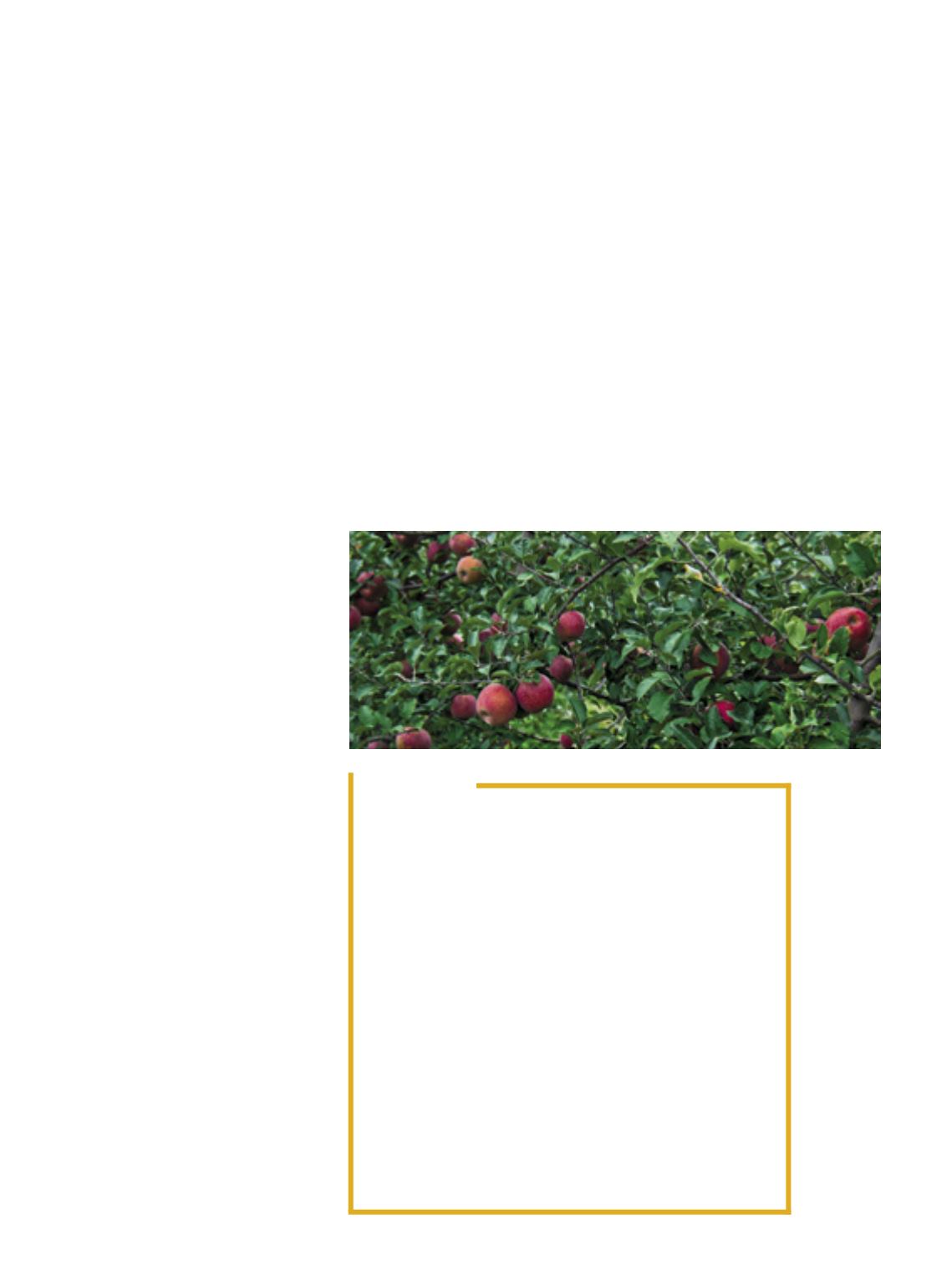
An eye-catching
orchard
Brazil harvests around 39million tons of
fruit a year, taking into considerationonly
22 species vastly cultivated throughout the Country
T
he latest report by the Municipal
AgriculturalProduction(MAP)de-
partment, of the Brazilian Insti-
tute of Geography and Statistics
(IBGE), that came out in August
2017, points out that in 2016 Brazil harvest-
ed 38.8 million tons of fruit, in more than
2.5 million hectares. Compared to the previ-
ous year, production was down 1.2 percent,
totaling 39.2 million tons, and area dropped
2.2 percent. The value fetched by the activity
reached R$ 33.3 billion, representing a posi-
tive variationof 26 percent fromthe previous
year,signalinganexcellentresultasfarasval-
uegoes. Themunicipalityof Petrolina, inPer-
nambuco, has the biggest share in the total
valueofthenationalproduction,with1.9per-
cent, followed by São Joaquim, in Santa Ca-
tarina;CasaBranca,inSãoPaulo;andVacaria,
inRioGrandedoSul.
Inall,inthevastandvarieduniverseofthe
fruit,theCountryoffersinthevariousregions,
only 22 species represented in theMAP, three
are classified as temporary crops (pineapple,
watermelon and melon) and the remaining
19 belong to permanent crops: avocado, ba-
nana, persimmon, cashew nut, Bahia Coco-
nut, fig, guava, orange, lemon, apple, papa-
ya, mango, passion fruit, quince, nut, pear,
peach, tangerine and grape. The six main
fruit arebanana, pineapple, grape, appleand
papaya, and they represent 73.2 percent of
the value of the entire national production.
The items that fetch the best average prices
per unit arenut, chestnut and fig.
The production of oranges alone corre-
sponded to 17.2 million tons harvested in
658,945 hectares in the Country in 2016,
valued at nearly R$ 8.4 billion, up 47.2 per-
cent from 2015. Banana, second most pro-
duced in Brazil, with 6.7 million tons har-
vested in 469,711 hectares, has equally
fetched upwards of R$ 8.3 billion in the
year in question. This amount represents
l
A PLAN
The Ministry of Agriculture, Livestock and Food Supply (Mapa)
is supposed to launch in the first quarter of 2018 the National Fruit
Farming Development Plan. The objective, according Ricardo Caval-
canti, advisor to the Executive Secretariat of the entity, consists in de-
vising action strategies and policies for the sector in order to qualify
the production further, increase domestic consumption and exports.
Now, Brazil is the third biggest global producer of fruit, coming only
after China and India, but exports only 2.5 percent of its production,
without taking into consideration fruit juices.
Theprojection is for the shipments togoupby 50percent over the
next two years. For production, the plans are more ambitious, with
the perspective for the country to produce twice as much fruit in five
years. According to the Brazilian Fruit Growers and Exporters Asso-
ciation (Abrafrutas), entity that is a partner in the plan, the Country
ranks 23rd in global fruit exports. In 2017, the national shipments, in-
cluding nuts and chestnuts, amounted to 878.4 thousand tons, with
revenue of US$ 946.8million, representing respective increases of 7.8
and 11.1% from the previous year.
25 percent of the total value of the Brazilian
production of fruit and 43.4 percent more
than in the previous year. Pineapple ranks
third, with 68,699 hectares, production of
1.8 million tons and revenue of R$ 2.4 bil-
lion, according to IBGE sources.
Currently, one of the most important re-
gions as far as fruit farming goes, is São Fran-
cisco Valley, at the borders of the states of
Pernambuco and Bahia, where the munici-
palities of Petrolina and Juazeiro are of note.
In this area, themain focus is the internation-
almarket, seeing that high technology, along
with different factors like climate and irriga-
tion, ensure fruit of discerning quality. The fi-
nalnumbersattestthatSãoPauloistheState
that leads production, with 30.9 percent of
the national value of the fruit in 2016, fol-
lowed by Bahia, with 12.2 percent. In the se-
quence, we have the States of Minas Gerais
and Rio Grande do Sul, which, together,
raked inupwardsof R$5.5billion fromfruit.
Inor Ag. Assmann
48


